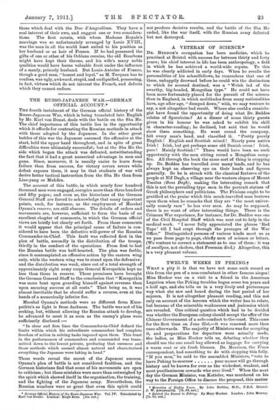THE RUSSO-JAPANESE WAR.—GERMAN
OFFICIAL ACCOUNT.* THE fourth instalment of the German official history of the Russo-Japanese War, which is being translated into English by Mr. Karl von Donat, deals with the battle on the Sha Ho. The chief importance of this battle lies in the opportunity which it affords for contrasting the Russian methods in attack with those adopted by the Japanese. In the other great battles of this war the Japanese assumed the offensive at the start, held the upper hand throughout, and in spite of great difficulties were ultimately successful; but at the Sha Ho the side which began the attack was defeated, notwithstanding the fact that it had a great numerical advantage in men and guns. Since, moreover, it is usually easier to learn from failure than from success, for victory covers errors while defeat exposes them, it may be that students of war will derive better tactical instruction from the Sha Ho than from Liao-yang or Mukden.
The account of this battle, in which nearly four hundred thousand men were engaged, occupies more than three hundred and fifty pages; and even so, the historians of the German General Staff are forced to acknowledge that many important points, such, for instance, as the employment of Marshal Oyama's reserve, are still obscure. The details of orders and movements are, however, sufficient to form the basis of an excellent chapter of comments, in which the German official views are briefly but clearly set forth. From these comments it would appear that the principal cause of failure is con- sidered to have been the defective will-power of the Russian Commander-in-Chief. This fault was reflected first in the plan of battle, secondly in the distribution of the troops, thirdly in the conduct of the operations. From first to last the Russian battle was half-hearted. The plan was feeble, since it contemplated an offensive action by the eastern wing only, while the western wing was to stand upon the defensive; and the distribution was weak, since out of a total strength of approximately eight army corps General Kuropatkin kept no less than three in reserve. These premisses have brought the German General Staff to the conclusion that " Kuropatkin was more bent upon guarding himself against reverses than upon securing success at all costs." That being so, it was almost inevitable that he should suffer a reverse, even at the hands of a numerically inferior foe.
Marshal Oyama's methods were as different from Kuro- patkin's as light is from darkness. The battle was not of his seeking, bat, without allowing the Russian attack to develop, be advanced to meet it as soon as the enemy's plans were sufficiently disclosed :—
"In clear and firm lines the Commander-in-Chief defined the limits within which his subordinate commanders had complete freedom of action in solving tasks imposed upon them. This trust in the performances of commanders and commanded was trans- mitted down to the lowest private, producing that sureness and those methods which seemed almost natural and characterized everything the Japanese were taking in hand."
Those words reveal the secret of the Japanese success. Oyama's plan of battle is not considered faultless, and the German historians find that some of his movements are open to criticism ; but these mistakes were more than outweighed by the spirit which showed itself in the organisation, the training, and the fighting of the Japanese army. Nevertheless, the Russian numbers were so great that even this spirit could
• Gilii1411'01414 lifigt011i lithe Busso-Japwasse War. Vol: iv. Translated by Bari ton Donat. London; ugh Rees. 0.5s, net.]
not produce decisive results, and the battle of the Sha Ho ended, like the war itself, with the Russian army defeated but not' destroyed.


















































 Previous page
Previous page